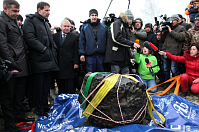Czech scientists reveal origin of Chelyabinsk meteor
CR: Scientists from the Czech Astronomical Institute believe they have found the origin of the Chelyabinsk meteor that hit Russia in February. In a paper published in Nature magazine, they suggest the meteor split from a larger asteroid some 10,000 years ago in a collision that directed it towards the Earth. The scientists also warn that the risk of similar asteroid strikes is much higher than previously thought. I spoke to one of the authors of the paper, Jiří Borovička.
 People look at what scientists believe to be a chunk of the Chelyabinsk meteor, recovered from Chebarkul Lake, photo: CTK“We studied the origin according to the asteroid’s orbit around the Sun which we computed from our analyses. Rather surprisingly, we found that the orbit is very similar to that of the well-known asteroid 86039. So we looked at the probability that the two orbits’ similarity was due to pure coincidence, and we found it was 1:10,000.
People look at what scientists believe to be a chunk of the Chelyabinsk meteor, recovered from Chebarkul Lake, photo: CTK“We studied the origin according to the asteroid’s orbit around the Sun which we computed from our analyses. Rather surprisingly, we found that the orbit is very similar to that of the well-known asteroid 86039. So we looked at the probability that the two orbits’ similarity was due to pure coincidence, and we found it was 1:10,000.
“So it’s quite likely – not proven but quite likely – that the Chelyabinsk asteroid and the bigger asteroid, with the diameter of about 2 km – were some time ago part of one body; they have common origin.”
Did you also find out when and how the Chelyabinsk meteor separated from the bigger body?
“According to the most likely scenario, a collision of two asteroids occurred some 10,000 years ago, one of them being the parent body of the Chelyabinsk asteroid. During the collision, the smaller Chelyabinsk asteroid was released from the bigger body. It gained the velocity of the order of 1 km per second. That’s how its orbit changed a little bit from the orbit of the parent asteroid.”
You have also arrived at a conclusion that strikes similar to that of the Chelyabinsk asteroid are more likely to happen than previously thought. Why is that – and what are the risks?
“This conclusion was presented in another study for the Nature magazine. Its main author is the Canadian astronomer Peter Brown, and I’m a co-author of the paper. This is a statistical analysis based on past few cases including the Tunguska event which occurred in 1908, the Chelyabinsk asteroid, and few other meteorite impacts recorded by infrasonic stations.
 Jiří Borovička, photo: Packa, CC BY-SA 3.0“All these events put together suggest that the impacts of asteroids in the size range from 10 metres to about 50 metres seem to be more frequent than previously estimated, basically from extrapolation from bigger asteroids. This is statistics of small numbers; it’s still rather uncertain but there is rather is a suggestion that impacts like than in Chelyabinsk may be more frequent – maybe not once per century but once per 20 years over the global.
Jiří Borovička, photo: Packa, CC BY-SA 3.0“All these events put together suggest that the impacts of asteroids in the size range from 10 metres to about 50 metres seem to be more frequent than previously estimated, basically from extrapolation from bigger asteroids. This is statistics of small numbers; it’s still rather uncertain but there is rather is a suggestion that impacts like than in Chelyabinsk may be more frequent – maybe not once per century but once per 20 years over the global.
“In the case of Chelyabinsk, we saw there may be dangers involved so it’s worth studying them in more detail and intercepting them with our telescopes and with bigger telescopes in the future.”
Jan Richter
